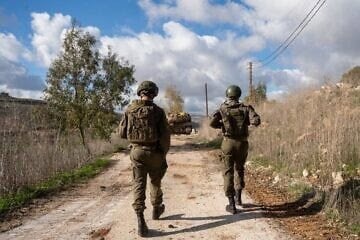Israeli security assessment details the IDF’s crippling blow to Hezbollah’s command as well as its rocket and tunnel capabilities in 2024 operation.
Yaakov Lappin
(JNS)
The Israel Defense Forces inflicted a devastating blow on Hezbollah during the September 2024 Operation Northern Arrows against the Iranian-backed terror organization in Lebanon, dismantling from 70 to 80 percent of its short-range rocket launchers, killing or wounding thousands of its operatives and rendering its elite Radwan commando force incapable of launching a large-scale invasion of the Galilee, according to Israeli security official.
The official shared a comprehensive recent assessment by the IDF’s Northern Command, noting that the IDF has shifted to a new “forward defense” posture, operating from five outposts inside a southern Lebanese buffer zone.
The goal of this presence is to maintain “strategic superiority in the area,” he said. “The IDF operates from these outposts to strike remaining weapons and infrastructure near the border, prevent Hezbollah’s involvement in rebuilding the arena, restrict Hezbollah operatives’ freedom of movement and instill a sense of susceptibility and vulnerability within Hezbollah.”
As part of this effort, the official noted, the IDF has more than doubled its forces deployed along the Lebanese border.
According to the Israeli assessment, Hezbollah’s ability to threaten the Israeli home front has been severely degraded. The dismantling of the vast majority of its short-range rocket launchers has reduced its projectile fire capabilities to “small-scale volleys,” with the group experiencing difficulty in coordinating even these limited barrages.
The damage inflicted has significantly decreased the threat to the IDF’s own air defense systems and has curtailed Hezbollah’s ability to strike Israeli communities to “sporadic, isolated launches,” according to the assessment.
The terror group’s much-vaunted elite Radwan Force, which for years trained to invade northern Israel and seize communities under a plan known as the “Galilee invasion,” on which Hamas modeled its Oct. 7, 2023, attacks on the western Negev, has been effectively neutralized as a major offensive threat.
The security official stated that the “Radwan Force is currently not fit for a large-scale offensive operation.” This is a result of a concerted Israeli campaign that dismantled all of the Radwan Force’s infrastructure, numbering in the hundreds of sites, along the entire frontline.
A key component of Israel’s strategy was the destruction of Hezbollah’s so-called “underground land” in southern Lebanon. The official detailed how the IDF located and dismantled approximately 1,500 underground infrastructure sites, including bunkers, command posts, and weapons depots. This effort dealt a “significant blow to Hezbollah, particularly affecting how operatives survive and weapons are stored in the area.”
The IDF also located and eliminated all of Hezbollah’s offensive tunneling infrastructure, including one cross-border attack tunnel. The campaign has led to an adaptation of the IDF’s combat doctrine for underground warfare in the northern arena.
The human cost to Hezbollah has been substantial. According to the Israeli assessment, between 4,000 and 5,000 Hezbollah commanders and operatives were eliminated during the fighting, with an additional 9,000 removed from the group’s combat reserves.
The loss of senior commanders has left Hezbollah’s leadership with a “sense of vulnerability and unfamiliarity with the terrain and operational framework,” said the military official. The organization as a whole has suffered a “significant blow to its morale and operational continuity,” he added.
With the ceasefire in effect, the IDF has transitioned to a new strategy designed to enforce the terms of the agreement and prevent Hezbollah from recovering. The primary Israeli objectives are preventing the re-establishment of Hezbollah’s operational presence south of the Litani River and dismantling any remaining ability to manufacture or deploy weapons. To achieve this, the IDF is operating through two main efforts.
The first is a “forward defense” posture via five outposts established in a buffer zone inside southern Lebanon. These outposts are aimed at “maintaining strategic superiority in the area.” From these positions, the IDF strikes remaining weapons and infrastructure, prevents Hezbollah’s involvement in rebuilding the area, restricts the freedom of movement of its operatives, and instills a “sense of susceptibility and vulnerability within Hezbollah.”
The second effort involves enforcing the agreement with Lebanon by working with the established international mechanism in southern Lebanon, while continuing to conduct independent strikes and eliminations on terrorists and terror targets as needed.
This new security reality has allowed for the return of a majority of displaced northern Israeli civilians. Since the ceasefire began on November 27, 2024, some three-quarters of northern residents have returned to their homes. The IDF is also bolstering local security by establishing outposts within Israeli communities and expanding civilian defense squads.
In the Syrian arena, meanwhile, the fall of the Assad regime created a strategic opportunity for Israel to dismantle capabilities that belonged to the Iranian axis. The IDF acted to thwart and damage Iranian entrenchment in Syria, striking military targets in the Damascus, Homs, and Aleppo areas.
The campaign also targeted terrorist groups in southern Syria, intercepted weapons transfers on the Lebanon-Syria border, and significantly damaged the Syrian Air Force and its strategic weaponry. The official noted that during these operations, the IDF struck over 600 targets in Syria with more than 1,800 munitions.
This strategic advantage, the official stated, has been crucial in “cutting off the Shi’ite axis from Iran to Syria and Lebanon,” which, he said, will enable further restrictions on weapons smuggling to Hezbollah.
Image: Israel Defense Forces soldiers operate against the Hezbollah terrorist group in Southern Lebanon, Jan. 23, 2025. Credit: IDF.


